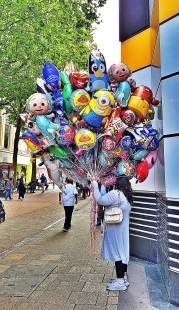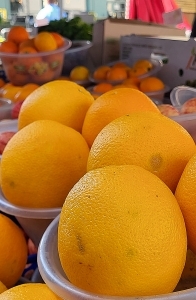Adam Yamey's Blog: YAMEY, page 44
July 31, 2024
Inflated
July 30, 2024
A collection of collectors’ collections in the heart of Croydon
COLLECTING IS A HOBBY, which is often very personal. People devote much of their spare time collecting all manner of things, from used beer cans to Persian carpets. What often seems to be a pointless collection of junk to most people, is an extremely important treasure to the collector. We used to visit a pub in Wadebridge (Cornwall), which has now changed owners. It used to contain about 300 working clocks. I asked the former owner, now sadly deceased, why there were so many clocks. She replied that some people have children, but she had clocks. Her collection was as important to her as children are to their parents. Something like this must be true for those who have made collecting their hobby, but I hope that their children (if any) are also highly valued by them.

Today, the 26th of July 2024, we travelled to Croydon to see an art installation, “Come as you really are”, created by the artist Hetain Patel (born 1980 in Bolton, UK), whose parents are British Gujaratis. The art show is being held until the 20th of October 2024 in what was once Grants department store, which opened in 1895 and finally closed in 1987. A man outside the building stopped us, and told us that he remembered being taken to Grants by his grandmother, who bought sewing materials there. Part of the former shop became a Wetherspoons pub called the Milan Bar, which ceased trading in 2022. The disused bar, which occupies two floors – ground and basement – is the site of Hetain’s literally incredible artwork (for want of a better word).
What Hetain has created and curated is a display of passionate collectors’ collections alongside a selection of his own creations (including a carpet covered car and a short video). Wandering around the former Wetherspoons pub is a cross between entering a dream world and the best junk shop you have ever seen. The experience is both extraordinary and visually amazing. The ‘show’ has been arranged under the auspices of Artangel, whose website (https://artangel.org.uk/project/come-as-you-really-are/) explained:
“The project began with a nationwide call-out inviting members of the public to share the activity to which they dedicate their spare time. Standing shoulder to shoulder with handmade submissions by hobbyists are new and existing works by Patel.”
The website further noted:
“Come As You Really Are by Hetain Patel features thousands of objects created, modified or collected by hobbyists across the UK, shown alongside a new artist film. Each hobby represents a decision to commit valuable time to living life on one’s own terms in a society dominated by consumerism.”
So, Hetain has made a collection of hobbyist collectors’ arrangements of their own collections, and distributed them artfully within the rooms of the former Milan Bar pub. The result has to be seen to be believed and to be enjoyed properly. As the website concluded:
“Come As You Really Are presents a variety of hobbies that showcase an individual’s freedom of expression and ingenuity, and in doing so broadens our perception of who gets to be called creative and where the impulse to create stems from. At the heart of this project is a nationwide community of people whose labours of love are a lens through which the artist presents an alternative portrait of the UK.”
We visited the ‘show’ from Kensington, but Artangel hopes that the majority of visitors will be from Croydon and its environs. They are aiming to bring art to the people. It is hoped that similar events will be held at various places all over the UK during the next few months.
July 29, 2024
An artist from Belgium at a gallery in London’s Mayfair
MICHAËL BORREMANS WAS born in Geraardsbegen in Belgium in 1963. He studied art in Ghent. This city and others nearby are rich in fine paintings by great Flemish artists such as Jan van Eyck, the Brueghels, Rubens, and Hugo van der Goes. These famous painters worked in the 14th, 15th, and 16th centuries. Their work often has a particular kind of clarity, which is especially evident in the portraits they painted.
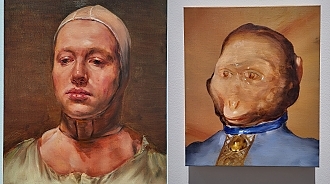
Two paintings by Borremans
The works of Borremans, which are on display at the David Zwirner gallery in London’s Mayfair until the 26th of July 2024, include portraits painted recently. Although they depict modern subjects, their visual quality and fine execution reminded me of the Flemish artists, who worked many centuries ago. Borremans paintings are not imitations of the works of the earlier Flemish artists but the effect his paintings have on me does not differ markedly from what I experience when viewing the Flemish art of many centuries ago.
Some of the paintings by Borremans depict the faces of monkeys dressed up in human clothes – 18th century painter’s garb. These paintings were inspired by a work created by Jean Siméon Chardin, who worked in the 18th century. The monkey depicted was not a real one, but a glazed porcelain model. I am not sure what message is being portrayed in these intriguing works.
The exhibition at Zwirner was well worth seeing. The pictures were well hung and beautifully lit, and a breath of fresh air, artistically speaking. Sadly, by the time you read this, it will be over.
July 28, 2024
An abbey at one end of London’s Elizabeth Line railway
ONE BRANCH OF London’s recently opened Elizabeth Line terminates at Abbey Wood, which is in the southeastern Borough of Bexley. A few minutes’ walk away from the station brings one to a large park called Abbey Wood, which I visited for the first time yesterday, the 24th of July 2024. The park contains the ruins of a 12th century Augustinian abbey – Lesnes Abbey.
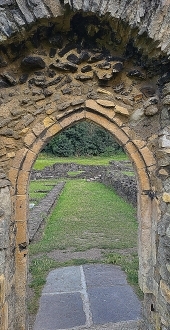
The abbey was founded in 1178 by Richard de Luci (1089-1179), Lord of the Manor of Lesnes and Chief Justiciar of England (something analogous to a modern ‘Prime Minister’). It is believed that he founded the abbey as a repentance for his sins and also for those related to the murder of Thomas a Becket in Canterbury cathedral in 1174. Unfortunately, Lesnes never became established as one of Engand’s greater monastic institutions. This might have been due to the large amounts of money it had to expend on draining its pastures, which were regularly flooded by the waters of the nearby River Thames. In addition, the abbey developed a bad reputation because of its members disorderliness, which included many instances of immoral behaviour. Despite help from outside sources, the abbey continued to decline until it was dissolved (in 1525), along with many other religious establishments, by King Henry VIII.
After it was closed, the land and remains of the Abbey passed through various hands until it was bequeathed to Christ’s Hospital School in 1688. Between that date and 1933, the land was used as a farm by the school. From 1909 to 1913, the Woolwich and District Antiquarian Society carried out extensive archaeological investigations of the site of the abbey. One of their many discoveries was a stone effigy of a knight, who could be identified as being part of the de Luci family. It is now stored in the Victoria and Albert Museum in South Kensington. From 1939 to 1954, the new owners of the land, the London County Council, carried out further excavations. After that, in 1956, the ruins were made safe for visitors, and these can be viewed today. In 1986, the park and the ruins were transferred to the care of Bexley Borough Council, who have made the place very ‘user-friendly’ with excellent paths, helpful direction signs, information panels, and a lovely visitors’ centre with a small café.
The ruins are quite extensive and seen from a hillock above them, one can clearly see the ground plan of the abbey. Most of the ruins are low in stature, but a few walls of over 6 feet high are still standing. In what was once the abbey’s church, there are several carved pillar bases and other fragments of the original structure. Nothing apart from its ground plan remains of the cloisters, which were filled with picnickers and children when I visited. All in all, the ruins of Lesnes Abbey compare well with others I have seen during my travels in England and Wales. But they are not as spectacular as, say, Tintern Abbey in Wales and Fountains in Yorkshire. However, unlike the two mentioned, which take many hours to reach from London, Lesnes is a mere 26 minutes’ train ride from Bond Street.
I had not known of the existence of the ruins of Lesnes Abbey until a few days’ ago when I looked up mulberry trees on the Internet. One of the examples of mulberry trees that came up on the screen of my computer was that which is growing next to the ruins of Lesnes Abbey. According to the excellent guidebook to the abbey by Chris Hawkins, which I bought at the café, the mulberry at Lesnes was probably planted in around 1720. It was during this period that the monarch, hoping to establish an English silk industry, imported many mulberry trees to England. Unfortunately, the enterprise was doomed to failure because mulberry trees of the wrong variety were imported – the kind whose leaves were not suitable for feeding silkworms. The ancient mulberry tree at Lesnes is flourishing but has grown in such a way that its huge twisting trunk must be supported by steel struts.
I can strongly recommend a trip to Abbey Wood to view the ruined abbey. Having seen it, I am surprised that this fascinating site it is not better known outside the confines of southeast London.
July 27, 2024
Leaning over but flourishing in Fulham
I ARRIVED EARLY for a committee meeting of the Anglo-Albanian Association, which was being held in a house in Walham Grove in London’s Fulham district. It was a warm afternoon, and as I did not want to disturb our host by arriving too early, I sat on a bench in the small yard next to the north side of St Johns Church – a rather unexceptional example of early 19th century church architecture.
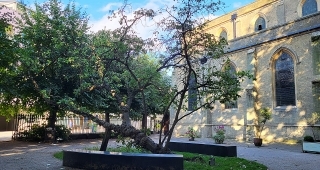
Soon, I noticed a tree in the middle of the yard. Its trunk was growing at about 30 degrees to the ground, and was supported by a wooden prop. Branches were growing out of the trunk, more or less vertically. There was a small commemorative notice at the base of the tree – where it had been planted originally. It bore the words:
“This mulberry tree was planted by His Worship the Mayor of Fulham Councillor JF Perotti JP on Victory Day June 8 1946”
On that day, celebrations were held in London to commemorate the Allied victory in WW2, the British Commonwealth, and the Empire. The Mayor, Mr Perotti, was a fitter at London Transport’s Lots Road electricity generating station.
In my mind, mulberry trees conjure up visions of silk growing and exotic landscapes of yesteryear. To be honest, until I saw the notice by the tree in the yard in Fulham, I would not have been able to identify a tree as being a mulberry. I stood up and examined it closely. To my great delight, I saw that the tree has berries. They looked like larger than average raspberries. I have read that when they ripen, they become darker in colour and resemble elongated blackberries.
I was curiously excited to find a mulberry tree with its fruit. I had not expected to find one in a busy part of Fulham. Mulberry trees have been grown in Britain since Roman times. One of the oldest surviving examples is in the garden of Canonbury Tower in Islington. It might have survived since the 16th century. There are several other slightly younger mulberry trees in London. So, the leaning example I saw in Fulham is a youngster on the scene.
July 26, 2024
Magnetism, Mecca, and an artist from Arabia
IT IS THE AMBITION of many Muslims to make a pilgrimage to Mecca. Part of this involves visiting a sacred black stone, the Ka’abah, which is cuboidal in shape. One part of the annual pilgrimage, the Haj, involves pilgrims circling the Ka’abah seven times clockwise – a ceremony known as the ‘Tawaf’.
The artist and physician Ahmed Mater, who was born in Saudi Arabia in 1979, has created artworks based on the pattern created by the pilgrims circling the Ka’abah, as seen from above. Some of these are aerial photographs, but others are based on magnetism. Those who have studied physics even at an elementary level will be familiar with the demonstration of the shapes of magnetic fields that can be achieved by scattering iron filings near a magnet on a sheet of paper. The magnet arranges the filings in a pattern that corresponds to the shape of its magnetic force field.

What Ahmed Mater did was to create a cubic magnet in the shape of the Ka’abah. Then he scattered iron filings around it on a sheet of paper. The filings then arranged themselves according to the magnetic field of the cuboid magnet. Next, the artist gave the magnetic miniature Ka’abah a twist. This caused the filings to rearrange themselves into swirls, which when viewed from above, resemble the pilgrims encircling the sacred stone in Mecca.
This simple artwork demonstrates not only the fascination of magnetism, but also the spiritual magnetism of the Ka’abah, which draws Muslims to Mecca. In discussing this work of art, Tim Mackintosh-Smith makes an interesting point:
“But Ahmed Mater’s magnets and that larger, Meccan lodestone of pilgrimage can also draw us to things beyond the scale of human existence, and in two directions at once – out to the macrocosmic, and in to the subatomic. In the swirl of Ahmed’s magnetized particles and the orbitings of the Mecca pilgrims are intimations of the whirl of planets, the gyre of galaxies.” (www.ahmedmater.com/essays/magnetism-tim-mackintosh-smith).
The artworks based on magnetism and the Tawaf, are just a small selection of the intriguing, beautiful works by Ahmed Mater, which are currently being exhibited at Christies in King Street (London) until the 22nd of August 2024.
July 25, 2024
Lloyd George on the railway tracks at Paddington station
IT IS NOT UNCOMMON to find that transport vehicles such as trains, boats, and aeroplanes, are given names. They are often named to honour noteworthy people. While strolling along platform 1 at London’s Paddington station today (21st July 2024), I noticed a train bearing the name ‘Megan Lloyd George CH’. You will, I hope, excuse my ignorance when I tell you that although I have heard of David Lloyd George (1863-1945), a former Prime Minister, Megan Lloyd George was not a name with which I am familiar. I wondered why the Great Western Railway (‘GWR’) had chosen to put her name on one of its trains. When I got home, I found out why.

Megan Lloyd George (1902-1966) was the youngest child of the Prime Minister David Lloyd George. She was born in Criccieth, Wales. Until she was four years old, she could only speak in Welsh. Between the ages of 8 and 20, she spent much of her life in the Prime Minister’s residence, 10 Downing Street. It is not surprising that the young lady became interested in politics. With some help from her father, Megan became the Liberal party candidate for the Welsh constituency of Anglesey, and in May 1929, she was elected as its Member of Parliament (‘MP’). She became the first woman MP from Wales. She was re-elected in the general elections of 1931 and 1935.
According to a biography (https://liberalhistory.org.uk/history/lloyd-george-megan/), Megan accompanied her father:
“… on his visit to Hitler in 1936, and opposed the policy of appeasement, urging him to press for Chamberlain’s resignation in May 1940.”
She served in Parliament throughout WW2, and was re-elected in 1945 and 1950, but with greatly reduced majorities. In 1952, she lost her seat.
For various political reasons, Megan and several other members of her party left the Liberal Party and joined the Labour Party in April 1955. In 1957, she became the Labour MP for Carmarthenshire, with a majority of 3000 votes. Always a popular figure, she took Carmarthenshire again in 1966, with a majority of 9000. By then, she was suffering from cancer, and died soon after the election and a few days after having been awarded the Companion of Honour (‘CH’) by Prime Minister Harold Wilson. In 2016, she was nominated as one of the ‘50 Greatest Welsh Men and Women of All Time’ (www.walesonline.co.uk/news/wales-news/50-greatest-welsh-men-women-11431779).
GWR trains run from Paddington to the west of England and parts of Wales including its capital, Cardiff. So, we should not be surprised to find Megan’s name on one of them. Having said that, I am not sure where the train with her name on it was heading as it left platform 1.
July 24, 2024
There was trouble in the Indian Ocean
EVER SINCE ROMAN times (and probably before), people in Europe yearned for products from Asia. Before 1498, highly prized goods such as spices and precious stones reached Europe from India and places further east via the Indian Ocean, and then overland, passing through places in the Middle East like Egypt and Turkey, before crossing the Mediterranean. Another route used for transporting these wares between India and Europe involved the use of rivers and overland caravan trails that carried them to the Caspian and Black Seas, and thence to Europe. At many points along these routes, the goods attracted taxes, which greatly increased the prices that people in Europe had to pay to purchase them.
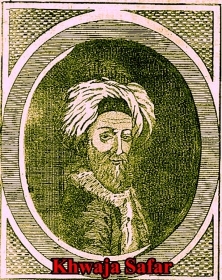
In 1498, the Portuguese explorer Vasco da Gama (c1460s – 1524) discovered a sea route from Portugal to India via the Cape of Good Hope. This discovery allowed Portuguese vessels to carry the highly prized goods from India to Europe by sea without having to pass through the lands where hitherto they had attracted high taxes and customs duties. Thus, the Portuguese were able to import the spices and other precious goods from the Orient at much lower prices than prior to Vasco’s discovery of the Atlantic route.
However, the Portuguese found that they were not the only traders making use of the Indian Ocean during the 16th century. Their competitors included Gujaratis, Egyptians, Arabs, Turks, and many others. It was not long before the Portuguese instituted measures to stifle competition and monopolise trade in the Indian Ocean. Naturally, this upset the merchants of other nations who traded in this sea. To stifle competition, the Portuguese resorted to harsh measures designed to make it almost impossible for their competitors to trade by sea. Over many years during the 16th century, attempts were made to oppose the monopolistic measures being forcibly imposed by the Portuguese, whose military and naval prowess was very formidable.
In 1508, a man called Khwaja Safar travelled from Egypt to begin trading in the Sultanate of Cambay (now ‘Gujarat’). Born in the south of Italy, his parents were Albanians. Having fought in armies in Europe in his youth, he was well-informed about the latest military techniques of European armies. By 1530, he began offering his services and military advice to the Sultan of Cambay. It was not long before he became involved both with negotiating with the Portuguese in India whilst simultaneously plotting against them. With the military experience he had gained as a young man in Europe, he became the commander of forces that repeatedly attacked the Portuguese, particularly in their important stronghold on the island of Diu – a place from which the Portuguese were able to watch and exert control on shipping to and from India.
My book, “An Albanian in India”, follows Khwaja from his birth in the ‘Heel of Italy’ to Egypt, then to Yemen, from there to Gujarat where he became a man of importance, and then to his untimely end during the attack on a Portuguese fortress on the coast of Gujarat. My book is available from Amazon, e.g.: https://www.amazon.co.uk/dp/B0D7HX2B8Q
July 23, 2024
An especially wonderful art gallery in a town in Cornwall
DESPITE BEING OVERRUN with tourists, the small fishing port of St Ives is one of my favourite places in Cornwall. Since the early 19th century, this picturesque place has attracted artists. With the decline of the pilchard industry in the 1880s, many of the buildings associated with this became vacant, and some of them were occupied by artists who converted them into studios. With the advent of the railway (in 1877), a means for easily transporting large canvases to London became available. It was not long before St Ives became an artists’ ‘colony’. In 1889, the St Ives Arts Club was founded as a place where artists could meet and socialise. It still exists. Its ground floor is used for temporary exhibitions. The upper floor is for members only, but I was lucky enough to have visited it with my friend, the late Michael Jacobs, who was writing his book, “Good and Simple Life: Artist Colonies in Europe and America”.
In 1927, the St Ives Society of Artists was formed. Its aim was (and still is) to raise the artistic standards of the artists’ colony and to exhibit works that they considered to be of significant quality. It was housed in various buildings in the town before 1945, when it moved into its present accommodation, the deconsecrated gothic church of St Nicholas. Exhibitions are held both in the church itself and in the crypt below it. The works of St Ives artists, who were considered avant-garde, such as Barbara Hepworth, Peter Lanyon, and Patrick Heron, were displayed alongside those of the town’s less adventurous artists, but were given less favourable positions in the exhibitions than the conventional creations. In 1946, several of the modernist artists held an exhibition in the crypt. They became members of a newly created Crypt Group. There were a couple more exhibitions by members of the Crypt Group in 1947 and the following year. Following a disagreement at an extraordinary general meeting of the Society in 1948, many of the members resigned including those who were included in the Crypt Group – some of Britain’s leading modern artists of the time.
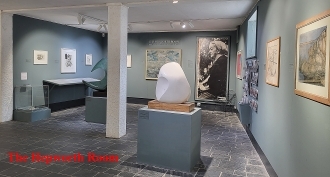
In 1949, some of the modernist artists in St Ives, including Barbara Hepworth, Ben Nicholson, Peter Lanyon, Bernard Leach, Sven Berlin and Wilhelmina Barns-Graham, founded a new organisation – The Penwith Society. Later members included the sculptor Henry Moore, Terry Frost, and Patrick Heron. Because of its association with Britain’s pioneers of modern art, the Penwith is a tangible, important landmark in 20th century British art history. In 1961, the Penwith occupied a disused pilchard packing factory, and over the years it has expanded into neighbouring buildings. As its website (https://penwithgallery.com/about-us/) explained:
“Today the Penwith offers a year-round programme of exhibitions by Society Members and Associates, as well as those by other artists from Cornwall and further afield. The Penwith continues to be at the forefront of presenting contemporary work of quality.”
Every time we visit St Ives, we visit the Penwith. Of all the numerous (commercial) galleries in St Ives, the Penwith consistently contains artworks of the highest quality and greatest visual interest. The exhibition areas are spacious and well-lit. One area in the gallery is called the ‘Hepworth Room’, which is used for exhibitions, but also contains a fine sculpture by Barbara Hepworth. A small courtyard, used to exhibit sculptures, contains a plaque, which reads:
“This foundation stone was laid by our friend and benefactor Dame Barbara Hepworth 10 January 1973”
It must refer to one of the many extensions made to the place since it was adopted by the Penwith in 1961.
I always enjoy visiting the Penwith. My advice to a visitor, who is short of time, is to forget the Tate St Ives, and instead make a beeline for the Penwith. Having said that, the Barbara Hepworth Sculpture Garden should also not be missed.

